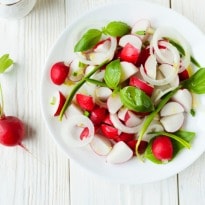While the concept of eating raw may leave some of us cold, health enthusiasts have jumped on to the bandwagon with both feet. Raw foodism or rawism is the practice of consuming uncooked, unprocessed and mostly organic foods. With chefs plating up gourmet raw recipes for more daring diners, raw foods are slowly but surely flourishing.This newest food fad is in fact a resurgence of what our ancestors have been harping upon. Raw foods are high on natural enzymes and nutrients that boost digestion and fight chronic ailments, most of which are destroyed on being cooked.Here's what I feel. Heat definitely adds depth to the texture and flavor of food, but it's good to step away from the stove every once in a while, and go raw. If you've been shying away from taking the raw route, getting your facts straight will give you a push. On International Raw Food Day, we bust five common raw food myths.
Myth #1: Frozen food is raw food.Frozen foods bought from groceries may not fall under the umbrella of raw foods as they are blanched before being packaged. Blanching helps prevent loss of colour and flavor but also reduces the nutritional perks. Frozen fruits are usually not blanched and may be included in your diet. You can freeze fresh raw foods at home and use them later.
Myth #2: Everything you eat on a raw food diet should be cold.Foods can be warmed to a temperature of about 118 degrees Fahrenheit (about 47 degrees Celsius) without affecting the nutritional value. Also, you can use blender and food processors to prepare them.
Myth #3: It only includes raw fruits and vegetables.Of course, there is a lot more than fruits and veggies that you can add to your menu. You can use seeds, nuts, dry fruits, sprouted grains, dates, raw honey, coconut milk, juices, smoothies and also certain processed foods like vinegar and cold-pressed raw oils. Cold pressed oils are obtained at lower temperatures and retain all their nutritional value. Olive, coconut and sunflower oil are commonly used. Some may even eat raw fish and meat.
Myth #4: You'll be eating less on a raw food diet.Your body requires the same amount of calories to function smoothly on a raw food diet as it does while following a regular diet. The only difference is that the emphasis is more on healthy natural sources and balancing the nutrients. A raw food diet is low in fats, cholesterol and sodium and high on fiber and vitamins.
Myth #5: One needs to go 100% raw to gain health benefits.First things first, you don't need to go 'cold turkey'. Embracing a healthy lifestyle is a process and one needs to work up to it. You can start with taking a day off every week to follow a raw food detox diet. With sudden dietary changes, you are more likely to backslide. Take your time to adopt and adapt. Start slow but remain steady. Nutritionists say that eating about 80 to 85 percent raw will make you feel as good.
Myth #1: Frozen food is raw food.Frozen foods bought from groceries may not fall under the umbrella of raw foods as they are blanched before being packaged. Blanching helps prevent loss of colour and flavor but also reduces the nutritional perks. Frozen fruits are usually not blanched and may be included in your diet. You can freeze fresh raw foods at home and use them later.
Myth #2: Everything you eat on a raw food diet should be cold.Foods can be warmed to a temperature of about 118 degrees Fahrenheit (about 47 degrees Celsius) without affecting the nutritional value. Also, you can use blender and food processors to prepare them.
Myth #3: It only includes raw fruits and vegetables.Of course, there is a lot more than fruits and veggies that you can add to your menu. You can use seeds, nuts, dry fruits, sprouted grains, dates, raw honey, coconut milk, juices, smoothies and also certain processed foods like vinegar and cold-pressed raw oils. Cold pressed oils are obtained at lower temperatures and retain all their nutritional value. Olive, coconut and sunflower oil are commonly used. Some may even eat raw fish and meat.
Myth #4: You'll be eating less on a raw food diet.Your body requires the same amount of calories to function smoothly on a raw food diet as it does while following a regular diet. The only difference is that the emphasis is more on healthy natural sources and balancing the nutrients. A raw food diet is low in fats, cholesterol and sodium and high on fiber and vitamins.
Myth #5: One needs to go 100% raw to gain health benefits.First things first, you don't need to go 'cold turkey'. Embracing a healthy lifestyle is a process and one needs to work up to it. You can start with taking a day off every week to follow a raw food detox diet. With sudden dietary changes, you are more likely to backslide. Take your time to adopt and adapt. Start slow but remain steady. Nutritionists say that eating about 80 to 85 percent raw will make you feel as good.
Advertisement











